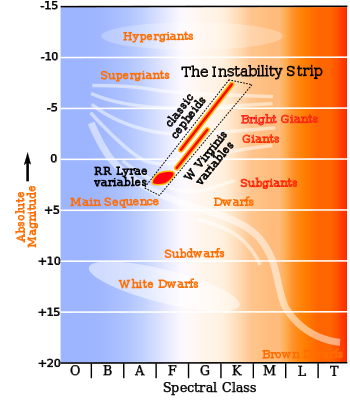 Some stars act as standard candles. Like a standard solution of known concentration in Chemistry, a standard candle is a star of known luminosity. Cepheid variable stars, a pulsing star following the red giant stage, act as standard candles.
Some stars act as standard candles. Like a standard solution of known concentration in Chemistry, a standard candle is a star of known luminosity. Cepheid variable stars, a pulsing star following the red giant stage, act as standard candles.
Key Concepts
Observations of cepheid variable stars have provided astrophysicists with data that shows a relationship between the period over which the cepheid variable star pulses and its luminosity. This is useful, as cepheid variable stars are bright enough to be observed over great distances, acting as a reference for determining the distance of other stars from us.
The pulsation of cepheid variable stars can be explained by their expansion and contraction:
- The core of the star produces heat, which is absorbed by the outer layer.
- This increases the temperature of the outer layer, which in turn expands.
- The outer layer now absorbs less radiation, so the net brightness observed increases.
- As this radiation is now escaping, the outer layer cools and contracts under gravity.
- The collapse of the outer layer causes the cycle to repeat.
Knowing the luminosity of a cepheid variable star from its period enables us to calculate its distance from Earth:
\(b={L\over{4\pi d^2}}\)
Rearranging: \(d=\sqrt{L\over {4 \pi b}} \)
- \(d\) is the distance of the cepheid variable star from Earth
- \(L\) is the luminosity of the cepheid variable star, determined using knowledge of the star's time period
- \(b\) is the brightness of the cepheid variable star, measureable at Earth
 Cepheid variable stars appear on the HR diagram in the instability strip along with other types of pulsating star.
Cepheid variable stars appear on the HR diagram in the instability strip along with other types of pulsating star.
How much of Cepheid variable stars have you understood?


 Twitter
Twitter  Facebook
Facebook  LinkedIn
LinkedIn